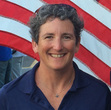Carol Newman Cronin's Blog, page 38
November 29, 2018
Stand Up Desk: Brain Change
In mid-October, I tweaked my back paddling by failing to adjust my habits to cooler weather. Too much sitting the day before, combined with the first chilly paddle of the fall, required more warmup time than I gave my muscles. So in protest, they tightened up—slightly out of whack. An hour after my paddle, I reached down to tie my shoes and transformed a tight discomfort to stabbing lower back pain. Yowza! The only cure was a weeklong conscious change of habits: not sitting down, not lifting anything, stretching several times a day, and supplementing World Series watching with lengthy e-stimulation (EMS) sessions*.
The not-sitting-down was the hardest part, since I had a long list of daily desk tasks. Midway through the week, I indulged a long-standing (hah) wish and ordered the parts needed to convert my mid-20th century teak desk to 21st century height variability. I won’t bore you with the installation details, but the result is amazing.
This sentence and all the preceding paragraphs were written sitting.

This sentence was written standing. Ta-DA!
(Can’t tell the difference in the writing, can you?)
In theory, I can’t tell the difference either. Same desktop, same computer screen, same keyboard and mouse; all at the same relative height and location to my eyeballs and brain.
In practice, though, that one push-button adjustment makes my mind work differently. I’m sure there are physiological explanations about blood flow and muscle activity, or maybe “expectations” about what problems we usually solve while standing up. For whatever reason, I think differently on my feet. I’m less contemplative and more efficient, which is good for cleaning out my inbox, writing a book review, or reading the blogs of others. For the woolgathering and mind meanders so crucial to first drafts, sitting still is best.
It’s taken some time to adjust, but I’m really enjoying the ability to change my perspective mid-project (or even mid-paragraph). When my back and hips start to stiffen from sitting too long, I just stand up—without interrupting my workflow. When my legs tire from standing in one place, I sit down again. Of course I still step away for water and food and pee breaks, but in between I can easily vary my posture and height while still staring at the same screen.
As devotees of standing (and walking) desks have discovered, standing doesn’t solve the sitting issue without creating a few issues of its own. The key to office worker happiness is variety, and listening to our bodies; they don’t want to stay in any single position for too long.
My back-stabbing pain took less time to heal than the Red Sox took to win the World Series, but the memory still makes me appreciate the luxury of living pain-free. I’m optimistic that changing my writing stance throughout each work day will keep my body working even better down the road. And who knows, it might also change what I write.
Now, if only I could find a way to make myself a little taller…
*For more about e-stimulation, here are two articles to read:
EMS: Why I’m a Believer (Brian Frank, founder of Hammer Nutrition, talks about why he bothers to promote and educate about EMS)
EMS: Secret Weapon to Recovery (a firefighter’s perspective on the relief it can bring to chronic back pain)
And if you’re curious, I installed a Jarvis Standing Desk Frame.
November 22, 2018
Giving Thanks x 4
Happy Thanksgiving! A year ago, I posted my top 5 reasons for being grateful, a list that still rings true; today I’m adding four more items that make me “bloom.” And to minimize the distraction for my faithful subscribers from a day best spent with family, friends, and food, I’ll keep it short today.

Flexible work schedule
So many times I get to do something fun during normal working hours, certain I can finish what needs to be done on my own schedule (and that I might even be rewarded for playing hooky). I can also go on self-defined trips during the week (like the recent SF ferry adventure), without any risk to a “regular” job. Being my own boss brings with it stress and uncertainty, but that’s all balanced against weekly doses of unexpected joy and daily doses of empowerment. Only I decide how to balance the various demands on my time.
Moving with purpose
I’ve been a regular (winter) client at The Island Heron yoga studio for three years, and some of my best blog posts are written before a 9am class. I show up ready for physical challenge and always leave mentally refreshed as well, which reminds me of the links between body and mind—as well as the Confidence of Quiet. Thanks Heidi, and the rest of the community!
Teammates in boats and books
Two people top this list: Paul Cronin and Kim Couranz. With Paul as coach, Kim and I won the 2018 Snipe Women’s Worlds by sticking to our very personal approach to regattas: No Drama, Llama. Paul inspires as well as redirects my sometimes crazy ideas, while Kim’s quick wit makes just hanging out with her really fun (and usually we get to go sailing, too). Thank you both for being such fantastic teammates.
On the writing and publishing side, I added a new name to my team this year: agent April Eberhardt. I’m very excited by the work we will do together in 2019 and beyond.
Readers
My final thought for today: Thank YOU, my weekly readers. Your comments and steady support keep me blogging on a regular schedule, and though I like to think you benefit from reading my posts, no one gets nearly as much out of it as I do. See you next Thursday!
November 15, 2018
November 8, 2018
Ode to Ferries, Real and Imaginary
I live in the neighborhood of West Ferry. My next book is titled Ferry to Cooperation Island. And last week, I got to ride across San Francisco Bay and back on a ferry—twice.

Traveling by water is so much more adventurous (and healthy) than traveling by road. Even a high-speed commuter route like the Larkspur (Marin County) Ferry, which runs to the Ferry Building in downtown San Francisco, might vary by a wavelet or three, and the air is salty-clean and stress-free. Judging by the acres of cars that fill every available ferry parking space each day, there are plenty of commuters who agree; who wouldn’t prefer a thirty-five minute ride across the Bay to a traffic-laden drive down 101, over the Golden Gate Bridge, and into the gridlock of a bustling city?
I traveled during non-peak hours, but the regulars were still easy to pick out (inside, staring at their phones). Meanwhile, out on the stern deck, we visitors snapped photos of the city front and reveled in hair-blowing breeze and sunshine.
I spent four days in the Bay Area and, between ferry rides, managed to pack in a wide range of experiences. First I checked out the FAST USA Olympic sailing program on Treasure Island (look for an article in Seahorse Magazine this winter). Next I lunched with my nephew Oliver (the original inspiration for Oliver’s Surprise) and his girlfriend, who are both settling into their first post-college jobs. I also had lunch with my agent, a rare face-to-face opportunity to review my publishing contract (and chat about sequels, sailing, the publishing industry, and book launch planning). Next up was dinner with a few Cronins, followed by a final-morning SUP out into a surprisingly windless Bay. Even on my last afternoon walk, blue water sparkled fog-free and—with the natural air conditioning of sea breeze shut down—the dry California air soared into the 80s. It’s easy to see why so many friends and family choose to live on the shoreline of such a glorious Bay.
The speedy San Francisco catamaran ferries are nothing like the single-hulled lumbering vessel in my next novel. But those two round trips still reminded me that ferries combine the best of both worlds; boating with commuting. Adventure with workaday. Enjoyment and efficiency. I was so grateful for my chauffeured rides into the city; so much more relaxing than driving around it, bumper to bumper and eyes darting between GPS and unfamiliar street signs. The captain might have diverted from the straightest route by a wavelet or three, but I could be certain we’d pull into the wharf right on time. And that has made all the difference.
November 1, 2018
Book Review: This Must Be the Place
For the past month, I’ve been reading several books concurrently—which is unusual. In addition to my nightly bedtime novel, I’m also working (slowly) through the information-packed density of Jane Smiley’s 13 Ways of Looking at the Novel. But as soon as I dipped my toe into the first chapter of This Must Be the Place, that immediately moved to the top of my reading pile; it was the “guilty pleasure” I returned to again and again, eager to find out what happened. It’s a page-turner for sure, because it combines perfectly unpredictable with perfectly logical.
What’s it about? I could go big and say, “It’s about love.” I could also go small; “It’s about a boardinghouse in a tiny upstate New York town.” Both are true, but the best answer is this: how carefully-kept secrets trickle forward into the future, staining everything they touch—until they are finally exposed.
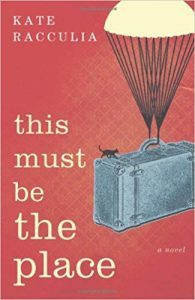 The prologue is entitled “sixteen years earlier,” and at first I found its lack of detail about setting and context—and the subsequent transition to a totally different point of view in the first chapter—confusing. As soon as I figured out the link between those two people, though, I had to know how it would all turn out. Author Kate Racculia trusts her readers to make connections, and as a result we learn to trust that she will give us just enough detail to propel us forward.
The prologue is entitled “sixteen years earlier,” and at first I found its lack of detail about setting and context—and the subsequent transition to a totally different point of view in the first chapter—confusing. As soon as I figured out the link between those two people, though, I had to know how it would all turn out. Author Kate Racculia trusts her readers to make connections, and as a result we learn to trust that she will give us just enough detail to propel us forward.
Memorable characters are what makes this book hum, so let me tell you a little bit about the three most important ones. My favorite is Oneida, who starts off by telling us that “Oneida Jones was a freak. It was non-negotiable. It was absolute.” A few pages later, Oneida tells us that “she hated her brain. It chewed on things—churned—whether she wanted it to or not.” Because she’s smarter than everyone else in her high school (teachers included), Oneida’s best friend is her mom, Mona, who runs the town boardinghouse and bakes wedding cakes.
Mona is a loner as well, and for sixteen years she has kept a big secret about her best friend from childhood. When that friend’s husband, Arthur Rook, moves into the boarding house, it’s just a matter of time before the secret comes out. And once Oneida realizes that her mom has been keeping secrets—just when she’s beginning to keep a few secrets of her own—it shatters her idea of who her mother is, who she is, and who this stranger might be.
As an author, I stopped to let my tongue roll over many of Racculia’s word choices (elegant, but totally different from what I would’ve come up with). There were two other distractions from racing through this story: a strange aside late in the book that tells us in way too much detail what will happen in ten years between two of the characters; and a few random phrases that didn’t make any sense to me. (They might have been cultural references that will ring true with more TV-aware readers.) I was enjoying the story too much to mark any of those, so I can’t provide specific examples; all I can say is “not quite perfect.”
I’d recommend this book for anyone who likes unpredictable novels told from multiple points of view, and for readers who prefer the “breadcrumb” approach; facts are dropped in front of us, just when we need them, letting us find our own way to the ending. Racculia’s third book is coming out next year, and it’s based in Boston this time; I can’t wait. Meanwhile, I’m going back to my other reading—and I’ll let you know how that turns out.
October 25, 2018
The Call of Fall
Somehow, this year’s transition from sticky-hot summer to cool dry fall came too fast. One day I was dripping sweat working in the yard, and the next I pulled on a sweater to sit at my desk. Welcome to October in New England.
But no matter how suddenly it arrives, fall is always a welcome chance to slow down. Priorities adjust, as inside projects rise to the top of the to-do list and boats are put to bed for their long winter’s nap. The off-season stretches ahead, deliciously distraction-free, with time to read and write and curl up on the window seat. Outside, each breath of crisp air scours my lungs clean.
Each change of seasons is, in its own way, inspiring, but fall is always my most creative time. Long hours at the keyboard become an oasis once the boats no longer sing their siren song. Falling leaves remind us to enjoy every moment, to—as my husband likes to say—have fun every day. The garden is muted, a lesson in the beauty of understatement.
Fall reminds us to live in the now. I savor each October swim, knowing that it could be the last one of the year. I don’t pine for the summer that’s gone, or dread the winter that lies ahead; I just enjoy a less crowded island, a slower pace, an idle conversation with a neighbor.
So whether it arrives suddenly like this year or creeps in more slowly, fall has a special place in my heart. It’s the best time of the year to slow down, breathe in, watch the leaves fall, take in the sunset. To simply Be. Here. Now.
October 18, 2018
Finding Kaci Cronkhite
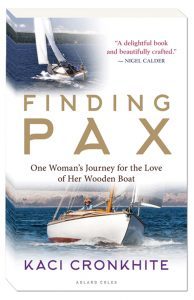 Thanks to modern communications, I have a lot of friends I haven’t yet actually met. Next week I get to meet one in person, when Kaci Cronkhite (author of Finding PAX) comes to town. On my invitation, she’s including a stop at the Jamestown Library on her Rhode Island speaking tour. (Join us October 27 at 330pm.)
Thanks to modern communications, I have a lot of friends I haven’t yet actually met. Next week I get to meet one in person, when Kaci Cronkhite (author of Finding PAX) comes to town. On my invitation, she’s including a stop at the Jamestown Library on her Rhode Island speaking tour. (Join us October 27 at 330pm.)
I blame it all on Piet Boidin.
I first met Piet, my Danish house-dad, when Kim and I stayed with him and his wife Pia for the 2011 Snipe World Championship. After learning I was an author, he was appalled that Kaci and I (two American boat-loving authors, living a mere 3000 miles apart) didn’t yet know each other. So he introduced us on Facebook… and the next time Kaci came to stay, Piet strategically placed his copy of Oliver’s Surprise on her bedside table.
Ever since then, Kaci and I have Facebook-cheered each other on from our opposite coasts as we navigated through books, boats, and the beauty of the world around us. And then last year, a small world moment brought us a little closer together: Kaci’s first book was discovered by an old friend, editor Molly Mulhern, which eventually led to this year’s publication of a second edition by Bloomsbury/Adlard Coles. As you can see, the new cover is spectacular—maybe part of the reason Finding PAX has been shortlisted for the UK Maritime Foundation’s Mountbatten Award.
The next small-world moment happened a month ago, when Kaci announced she would be talking at the Herreshoff Marine Museum in Bristol, RI. When I found out she had a few days to play, I offered to show her around—and then asked if she could fit in another presentation, here in Jamestown. “I love talking at libraries!” was her response. A few emails later we had a plan, and next week we will meet in person at last.
As the press release about Kaci’s upcoming visit puts it, “Finding PAX is far more than just a story of a wooden boat and her owner; it is a combination love story, quest, and international mystery that is destined, according to one review, ‘to take its place in modern wooden boat classics.’ Other reviews call it ‘a story of discovery and reconnection like no other’ and say the writing ‘is poetic, spare, and full of wisdom.’”
I can already attest to the accuracy of the glowing book reviews. Next week I’ll be able to tell you if Finding Kaci lives up to Piet’s equally glowing review of the author. I’m guessing the answer will be yes.
Locals: Join us at the Jamestown Philomenian Library, Saturday October 27, 3:30-5pm!
October 11, 2018
Quality Over Quantity
Shouters seem to be getting rewarded for their active-not-listening these days. We’re seduced by both the volume and velocity of their words, which are strategically intended to overwhelm rather than convince. Those of us who try to think before we speak, who choose our words more carefully, are simply drowned out.
 But before this becomes a political rant, I’ll move on to my intended topic: the benefit of prioritizing quality over quantity. In communications as well as several other aspects of life, I’m seeing a trend toward “more” rather than “better.” Flooded with options, we have too many choices in entertainment and news, and definitely too much blending of the two. (Maybe you think there are too many blog posts from your favorite author.) As our attention spans grow shorter, is there any way to escape back to more thoughtful interactions? Fewer words, spoken rather than shouted?
But before this becomes a political rant, I’ll move on to my intended topic: the benefit of prioritizing quality over quantity. In communications as well as several other aspects of life, I’m seeing a trend toward “more” rather than “better.” Flooded with options, we have too many choices in entertainment and news, and definitely too much blending of the two. (Maybe you think there are too many blog posts from your favorite author.) As our attention spans grow shorter, is there any way to escape back to more thoughtful interactions? Fewer words, spoken rather than shouted?
I spend a lot of time thinking about how long books and articles and blogs should be. Google “best word count for SEO” and even Forbes has weighed in (with a rather short post). Like skirt lengths there are yearly trends, though most advice seems to creep in the direction of “shorter,” with the occasional correction.
The answer I keep coming back to applies equally well to every piece I write: “Exactly as long as it needs to be.”
I recently finished a book called This Must Be the Place (you’ll read the review in a few weeks) that I thought was the right length; many other reviewers thought it was much too long. Because the writing was so lyrical, I didn’t mind most of the meanders that others found distracting. The answer will vary by reader—and by medium as well. If I’d read that book on a computer, I never would’ve made it all the way to the end.
So how do we know what’s “enough” communication in either length or frequency? Since it’s different for each one of us, there’s only one way to figure it out: turn off the constant barrage of opinions telling us what’s right every moment of every day, and listen to our own hearts.
And wouldn’t it be great if listening to our hearts led us to be better listeners in general? Paying so much attention to carefully chosen quality words that we tune out the quantity of shouting and yelling; less minds-made-up-already, more thoughtful discussion?
And since that is exactly as long as this post needs to be, I’ll end it right here.
PS: As always, I’m curious for your thoughts about this topic, so please add your comments below.
October 4, 2018
Book Review: Footprints in the Dust
Full disclosure: I don’t read a lot of memoir. I might not ever have stumbled onto Footprints in the Dust if its author, Roberta Gately, hadn’t first written two novels: Lipstick in Afghanistan and The Bracelet. Her lovely memoir comes out October 2nd, and I was lucky enough to read an advance copy.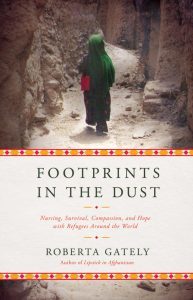
For more than twenty years, Gately arranged her “regular” career as an ER nurse in Boston around her true calling: helping refugees who’d fled their homes and left behind (as she puts it) “everything but hope.” For months at a time, she went where she was needed most—Pakistan, Afghanistan, Darfur—helping those who’d been displaced and wounded by wars that barely made the news back in the US. Even though she always seemed to pack the wrong clothes for the weather, she never shied away from a challenge; for one assignment, she even adopted a different passport (and accent) so she wouldn’t be targeted as an American.
Gately tells a great story, so we taste the dust and instant coffee, smell the latrines, and miss the wine and pizza right along with her. And even at the worst of times, we’re reminded of both beauty and humanity; our narrator’s positive warmth and belief in basic goodness always shine through.
In each location Gately clearly describes the challenges, but the focus is on her friends and patients (people she still carries in her heart, years later), and she describes them all so vividly that we feel like we’ve met a few of the world’s twenty-two million refugees. At their clinics, women and children were treated first, Gately explains; “Tradition in so many of these places required that men be first in everything—food, shelter, education—but these women and children would always come first for me.” On an early assignment in a small Pakistani village, Gately talks about meeting an older woman who used to be “somebody important,” and goes on to explain the wide gulf she needed to cross each time she met with a patient:
I couldn’t even imagine how hard it must be for these women who had been forced from their homes, from everything they knew. Their children—if not injured or sick—were hungry, their husbands at war, their land lost, their homes destroyed. How could I, how could any of us, who would all eventually go home to warm, safe homes, ever really know the extent of their suffering?
This is what memoir was meant to accomplish; by air-dropping us into history, it shows rather than tells through a single, carefully focused perspective, helping us to understand people we’ve never met.
I found the final section a bit repetitive, which made me wonder whether the author’s (or editor’s) enthusiasm had simply been worn down by such an endless stream of need. Over Gately’s decades of dedication, international aid work evolved from casual to structured, but that didn’t resolve the refugees’ problems. Even for such an optimistic angel-nurse-bulldog, trying to meet the same basic needs (food, clean drinking water, medical supplies, shade) over and over and over again must’ve been emotionally exhausting. But Gately doesn’t ever let herself wallow; even when faced with her own medical challenges, she focuses on others—and is eventually rewarded by the signs of progress she finds in a small village, months later, when she manages to visit once again.
As the book copy states, “Footprints in the Dust reveals the humanity behind the headlines.” By mining her memories and applying her storytelling talents, Gately has brought nameless, faceless refugees to life. She’s shown us the people torn from their homes by devastating political decisions, all while holding up a mirror to our commonality. “The only thing I need now,” one of the refugees tells Gately, “is to go home, to work in my garden again, and to die in my own land.”
For more, and to order your copy of Footprints in the Dust, visit Roberta Gately online.
September 27, 2018
Personal Story Power, Plus Preparation
On September 20th, 2018, the eve of the Hurricane of 1938’s 80th anniversary, a sizeable group of Jamestowners gathered at the library to hear fellow townsfolk read family letters that had been written just after the storm. No video, no flashy lighting, no History Channel drama—just regular folks, standing up to read what their equally regular forebears had written. It could’ve been boring, but thanks to excellent planning and preparation it was memorable instead; a great reminder of the impact of well-rehearsed personal stories.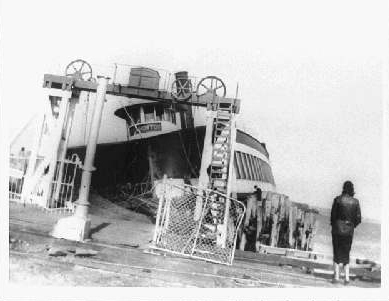
It was the detail in each letter that really brought the storm to life for those of us too young to have lived through it ourselves. Trees stripped bare, land browner than winter; goldenrod and birds, all gone. A sailboat’s crew saved only by their captain’s nose for bad weather and their own resourcefulness.
Working up my contribution to the evening, I had wondered whether our 21st century attention spans could handle such a quiet format. The answer was an emphatic ‘yes,’ but only because the evening was so well thought out. Organizer Sue Maden helped readers edit out anything beyond the storm’s impact on the island and its residents. The order or readings managed to knit together a chronology from unrelated family details. And each speaker was limited to a maximum of ten minutes. What I worried might be a restless crowd sat rapt, right to the bitter end. (I know, because I was the very last speaker.)
The next day, September 21, 2018, dawned sunny and clear, with a fast-building breeze—not terribly different from the morning the ’38 hurricane hit. As we headed out of the Bay to sail forty miles to Woods Hole, I was glad we didn’t have to rely solely on our noses to know there were no hurricanes brewing.
With so many glitzy presentation tools available now, it’s easy to forget how appealing a basic evening of shared personal memories can be. Give an audience a well-edited, carefully planned story, and you’ll keep ‘em hooked—right to the last word.



